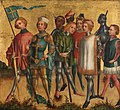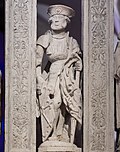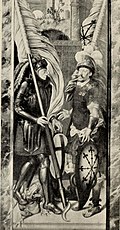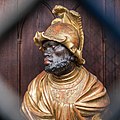Gregorius Maurus
Gregorius Maurus or Gregor Maurus († around 300 in Cologne ) is a saint of the Catholic Church. According to legend, he was an army leader of the so-called Theban Legion , who was executed as a Christian martyr under Emperor Maximian and Diocletian in Cologne together with his fellow soldiers . His feast day is October 15th.
Legend
The legend of Gregorius Maurus is partly related to that of the better known Saint Mauritius , the actual leader of the Theban Legion. Maximian , Diocletian's co-emperor , is said to have put together a legion in Egypt whose members came from Thebes in Upper Egypt. They were supposed to help his army put down rebellions in the Gallic and Germanic provinces. After the legionaries under Mauritius resisted the order to persecute Christians or refused to pay homage to pagan deities, the imperial cult , they were decimated , i.e. every tenth soldier was executed.
The martyrdom of the Theban Legion is spread across the saints legends from Northern Italy to Xanten on the Lower Rhine. The Cologne part of the legend, which speaks of 50 martyrs, has been passed down by the historian and hagiographer Gregor von Tours from the 6th century.
In the early 7th century, at the latest in the Passio S. Gereonis et sociorum of around 1000, the legend of St. Gereon was also interwoven with that of the Theban Legion. Gereon and Gregorius Maurus as leaders of the now 360 Roman soldiers "from Mauritania " are said to have refused to persecute Christians in Cologne or to have resisted the pagan sacrifice. Thereupon they were executed at St. Mechtern's in what is now Ehrenfeld, and their corpses were thrown into a well on Heerstrasse from Cologne to Venlo . The church of St. Gereon was built at this point or in its vicinity, which at the turn of the millennium was also called Ad Aureos Sanctos - "To the golden saints" - was called.
Relics
Archbishop Anno of Cologne (around 1010-1075) reports that the numerous members of the Theban Legion appeared to him in a dream and complained about the lack of veneration of their relics "in the narrow crypt". The "shiny crowd" judged him and sentenced him to corporal punishment, which was immediately carried out. In order to avoid further nightmares, Anno had the church of St. Gereon significantly expanded. During excavations under the marble floor of the church, the grave of Gregorius Maurus was finally found, who was dressed in a "purple robe" with fine gold mesh.
Gregorius Maurus is therefore named together with Gereon as a co-patron of the Romanesque church, occasionally also as the city patron .
A large, late Romanesque and silver-gilt reliquary of Gregorius Maurus, for whom "precious stones" were donated as early as the second half of the 13th century and which was recorded in a treasury register from 1370, according to Paul Clemens' inventory of monuments , probably went into the French period (1792 –1815) lost due to melting. Among other things, it stood together with a similar Gereon's shrine in the area of the high altar of the church.
In the middle of the crypt stood a sarcophagus ( tumba ) made of marble on six short columns at least until 1824 , in which the bones of Gregorius Maurus, raised under Anno , were kept. A late Romanesque inscription nearby read:
“PRINCEPS MAURORUM
GREGORIUS ALTA POLORUM
SCANDENS, AD MORTEM
DAT SEQUE SUAMQUE COHORTEM.
IN HAC TUMBA CONDITUM EST CORPUS
GREGORII PRINCIPIS ET MARTYRIS. "
“Gregory the Prince of the Moors
climbs the height of heaven,
since he surrenders himself and his legion to
the torture.
The body of
the prince and martyr Gregorius is buried in this crypt . "
iconography
Similar to Mauritius, Gregorius Maurus is often - but not always - portrayed as a black man (" Mohr "). Such representations can be found from the 11th century, the time of the first crusades . These first three- dimensional representations date from a time before one of the Three Wise Men had established himself as a black man in iconography.
A high point of the surviving images is between the 13th and 16th centuries. An inventory by Gude Suckale-Redlefsen from 1987 listed 18 black depictions of Gregorius Maurus, some of them as late as the 17th century. The saint is represented as a soldier or knight with the attributes of a turban, sword, banner and shield with a spoke-like cross. It also seems to be a peculiarity of Cologne that Mauritius is mostly represented as white, Gregorius Maurus, however, predominantly as black. Even if Gregorius Maurus cannot be clearly identified by his attributes in individual Cologne representations, Suckale-Redlefsen assigns him some unclear representations if they come from Cologne and show the saint as black.
| image | place | Time of origin |
|---|---|---|

|
Baptistery of St. Gereon, Cologne: wall painting. Left St. Gereon, right Gregorius Maurus | circa 1245 |
| St. Gereon, Cologne: Two reliquary busts in the sacristy, Gregorius Maurus and a companion. The original version is unknown as it has been renewed by a current deep black one. There are no other attributes. | around 1300-1310 | |

|
St. Gereon, Cologne, crypt: mural on the north wall of the second yoke in the chancel, originally with a martyr's palm and writing:
|
13th century |
| St. Gereon, Cologne, sacristy : glass window. |
1st half of the 14th century |
|

|
Gemäldegalerie , Berlin: Altarpiece of the Marien Altar in St. Gereon, Master of the Gereon Altar. In Halo , the name is called: SANCTUS GREGORIUS MAURU (S) | around 1420 |

|
Germanisches Nationalmuseum , Nuremberg , originally probably from the parish church of St. Brigiden, which was closed in 1803 . Altar wing St. Gereon with entourage . Quote Suckale-Redlefsen : “The figure behind Gereon wears a curly hair, a gemstone necklace and an earring. Although the clear sign of the cross is missing, it can be assumed that it is Gregorius Maurus. " | around 1460 |
| Golden Chamber of St. Ursula , Cologne: Reliquary bust of a St. Carrots. No typical attributes, but martyr's palm and bared sword, possibly not Gregorius Maurus, but another soldier of the Theban Legion. | around 1500 | |
| Parish Church of St. Margarethe, Brühl: Ursula shrine with a scene of execution by the Thebes - here too, due to the lack of clear attributes, it is rather unclear whether Mauritius or Gregorius Maurus is depicted. | ||

|
Royal Collection , Buckingham Palace , London: Triptych of the Coronation of the Virgin Mary with Hallows by the Bruges Master from 1499 . In the back row “the head of a holy Moor” - Mauritius or Gregorius Maurus. | approx. 1480-1500 |

|
Private possession / missing since an auction in Brussels in 1919: Triptych of St. Gereon and Gregorius Maurus with entourage. possibly from the environment of the Cologne master of Sankt Severin . In contrast to similar images, here Gregorius Maurus is in the foreground. | Early 16th century |

|
Cologne Cathedral : Typological window of the birth of Christ | 1507 |

|
Alte Pinakothek , Munich: Hll. Anno and Gregor der Mohr, Anton Woensam . 1802 as secularization property from the Prince-Bishop's Residence in Freising | 1520 |

|
St. Gereon, Cologne: reredos of a Renaissance altar in the apse of the crypt. The clear identification feature is the cross on the shield. | 1535 |

|
St. Andreas, Cologne: Altarpiece, Bartholomäus Bruyn the Elder , left: Saint George , right: possibly Gregorius Maurus, also called: Mauritius or Quirinus | 1540 |

|
Choir of St. Gereon, Cologne: Altarpiece of the Sebastian Altar (also: Sebastian Altar), attributed to Johann Hulsmann and Johann Toussyn. Donated by Alexander Symonis, provost of the Kunibertsstift and canon in St. Gereon. | 1635 |

|
Cologne City Museum , Graphic Collection: Johann Toussyn, History of the Patrone of Saint Gereon in Cologne | 1646/1. Half of the 17th century |

|
Cologne City Museum , Graphic Collection: Copper Engraving: The St. Helena receives the order from Saints Gereon and Gregorius Maurus to build the church of St. Gereon. | 1646 |

|
Formerly St. Gereon, Cologne, probably burned in the Second World War: painting Dream of St. Anno. | 2nd half of the 17th century |

|
Chancel of St. Gereon, Cologne: Bust of St. Gregorius Maurus, attributed to Hermann Kessel | 1683/1688 |
Modern reception
Mohrenstrasse in Cologne
The legend of Gregorius and the Thebaic Legion has not been forgotten in Cologne. In 1844 the church council of St. Gereon got the name of a new street in the immediate vicinity of the basilica after Gregorius - the original suggestion "Maurenstrasse" finally led to the name Mohrenstrasse.
In connection with debates about racist street names, some of which originate from or refer to the colonial era , Mohrenstrasse in Cologne also came under discussion in 2020. While some called for the name to be renamed and prepared a corresponding application to the district council, others pointed out the non-colonial origin of the street name. It was also suggested that the very idea of a black saint relativizes widespread Eurocentrism and the notion of “white saints”. The Africanist Marianne Bechhaus-Gerstthinks it at least not unlikely that a number of Rhineland church patrons were black. However, she also pointed out that the term "Mohr" is in any case, regardless of the etymology, out of date and discriminatory and a renaming therefore makes sense. In addition to a complete change of the dedication - for example after a "black African human rights activist" - there was also a proposal to rename the street to "Gregorius-Maurus-Straße".
literature
- Gude Suckale-Redlefsen: Catalog of the black Gregorius Maurus representations . In: Mauritius, the holy moor . Menil Foundation / Schnell & Steiner, Houston / Munich 1987, ISBN 3-7954-0240-9 , p. 274-281 .
Web links
- Jeff Bowersox, Julia Alcamo: Gregory the Moor (ca.1350-1683). In: blackcentraleurope.com. Retrieved October 29, 2020 (English).
Individual evidence
- ↑ a b Saints in the Cathedral: Gregorius Maurus (Gregor the Mohr). Retrieved October 30, 2020 .
- ↑ a b c d e Hiltgart L. Keller: Reclam's Lexicon of Saints and Biblical Figures; Legend and representation in the visual arts, (= Universal Library . No. 10154 ). 5th, revised and supplemented edition. Philipp Reclam jun., Stuttgart 1984, ISBN 3-15-010154-9 , pp. 270-271 .
- ↑ a b c Sanata Nacro: Mohrenstrasse. In : kopfwelten.org. KopfWelten - against racism and intolerance eV, accessed on October 30, 2020 .
- ↑ a b c Werner Schäfke: St. Gereon in Cologne . Cologne 1998, p. 5-13 .
- ↑ Helinandus Frigidi Montis : Passio S. Gereonis et sociorum. In: mlat.uzh.ch. JP Migne, 1855, accessed on November 2, 2020 (Latin, the author is incorrectly transmitted here).
- ^ Gertie Gretz, Otto Koch: St. Gereon in Cologne . Bonner Universitäts-Buchdruckerei, Bonn 1939, p. 153 .
- ↑ a b Ulrike Brinkmann: Typological Nativity Window. In: koelner-dom.de. Metropolitan Chapter of the High Cathedral in Cologne, accessed on October 28, 2020 .
- ^ Peter Joerres: Document book of the St. Gereon Abbey in Cologne . Hanstein, Bonn 1893, p. 450, 452 , urn : nbn: de: hbz: 061: 1-97418 .
- ^ Paul Clemen (ed.): The church monuments of the city of Cologne. St. Gereon, St. Johann Baptist, The Marienkirchen, Gross St. Martin . tape 1 . L. Schwann, Düsseldorf 1980, p. 84 .
- ^ Paul Clemen (ed.): The church monuments of the city of Cologne. St. Gereon, St. Johann Baptist, The Marienkirchen, Gross St. Martin . tape 1 . L. Schwann, Düsseldorf 1980, p. 77 f .
- ^ Anton Engelbert d'Hame: History of the building and foundation of the Church of Saint Gereon in Cologne: dedicated to pious Christians, art connoisseurs and friends . Mennig, Cologne 1824, p. 64–65 , urn : nbn: de: hbz: kn28-1-7569 .
- ↑ a b c d e f g h i j k l m Gude Suckale-Redlefsen: Catalog of the black Gregorius Maurus representations . In: Mauritius, the holy moor . Menil Foundation / Schnell & Steiner, Houston / Munich 1987, ISBN 3-7954-0240-9 , p. 274-281 .
- ↑ a b c Gottfried Stracke: Treasury and sacred place. The Gothic sacristy and the treasure of St. Gereon today . In: Förderverein Romanische Kirchen Köln (Hrsg.): Colonia Romanica: Yearbook of the Förderverein Romanische Kirchen . tape XXXIV . Bachem, Cologne 2020, ISBN 978-3-7510-1219-5 , pp. 106-106 .
- ^ Anne Kuhlmann-Smirnov: III.2.5 The black saint Mauritius . In: Black Europeans in the Old Reich: Trade, Migration, Hof (= Transcultural Perspectives . Volume 11 ). Vandenhoeck & Ruprecht, Göttingen 2014, ISBN 978-3-8471-0186-4 , pp. 105 ( limited preview in Google Book search).
- ↑ Anna Skriver: Unusual and multifaceted. The baptistery of St. Gereon as an overall design concept from the middle of the 13th century . In: Förderverein Romanische Kirchen Köln (Hrsg.): Colonia Romanica: Yearbook of the Förderverein Romanische Kirchen . tape XXXIV . Bachem, Cologne 2020, ISBN 978-3-7510-1219-5 , pp. 72 .
- ^ Paul Clemen (ed.): The church monuments of the city of Cologne. St. Gereon, St. Johann Baptist, The Marienkirchen, Gross St. Martin . tape 1 . L. Schwann, Düsseldorf 1980, p. 84 .
- ^ Heinrich Oidtmann: The Rhenish stained glass from the 12th to the 16th century . L. Schwann, Düsseldorf 1912, p. 206 f . ( archive.org [accessed on November 6, 2020] with b / w illustration).
- ↑ SMB digital | Marien Altar from St. Gereon. Retrieved October 28, 2020 .
- ↑ Collection | Altar wing: St. Gereon with entourage. Reverse: Mary of the Annunciation (upper section). Retrieved November 6, 2020 .
- ↑ The church monuments of the city of Cologne. St. Alban, St. Andreas, Antoniterkirche, St. Aposteln, St. Cäcilia, St. Columba, St. Cunibert, Elendskirche, St. Georg . tape 4 . L. Schwann, January 1, 1916 ( wikidata.org [accessed November 2, 2020]).
- ↑ Crucifixion Triptych v. Barth. Bruyn. Retrieved November 2, 2020 .
- ↑ Cologne's cultural heritage: Hulsmann, Johann, Sebastian Altar. Retrieved October 29, 2020 .
- ↑ Johannes Hulsman and Johann Toussyn. Retrieved October 29, 2020 (Dutch).
- ^ Margrit Jüsten-Mertens: The Cologne sky . In: Stefan Lewejohann (Hrsg.): Cologne in unholy times: the city in the Thirty Years War . (Accompanying volume to the exhibition of the Cologne City Museum from June 14 to October 5, 2014). Böhlau, Cologne 2014, ISBN 3-412-22411-1 , p. 145-147 .
- ^ Cultural heritage Cologne: Kessel, Hermann, Altar with the busts of Gregorius Maurus and Gereon. Accessed November 1, 2020 .
- ^ Rüdiger Heimlich: Mohrenstrasse is to be renamed; SPD local association calls for a racism debate - Africanist advocates another name . In: Kölner Stadt-Anzeiger . Cologne July 9, 2020, p. 21 .
- ^ RP ONLINE: Renaming of street names: Africanist criticizes discussion about Cologne's “Mohrenstrasse”. Retrieved October 30, 2020 .
- ^ Süddeutsche Zeitung: The Mohrenstrasse debate reaches North Rhine-Westphalia. Accessed November 1, 2020 .
| personal data | |
|---|---|
| SURNAME | Maurus, Gregorius |
| ALTERNATIVE NAMES | Maurus, Gregor |
| SHORT DESCRIPTION | Saint of the Catholic Church |
| DATE OF BIRTH | 3rd century |
| DATE OF DEATH | at 300 |
| Place of death | Cologne |


